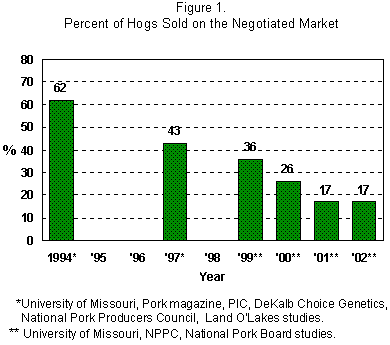University of Missouri and National Pork Board*
January 2002
![]()
The January data for the hog marketing arrangements or marketing contracts in the mandatory price reporting information was summarized.
The definitions for the marketing arrangements in the mandatory price reporting legislation are not the same as the definitions of arrangements reported in similar studies conducted by the University of Missouri and the National Pork Board in previous years. Therefore, direct comparisons for each type of marketing arrangement are not possible. However, the spot market or negotiated groups, we believe, are directly comparable so this very important portion is consistent with previous studies.
Here are the different arrangements reported in the mandatory price reporting information:
Total hog slaughter under Federal Inspection in January 2002 was 8,551,000 head. Data for 7,593,155 head (88.8% of January FI slaughter) are included in the mandatory price reporting system.
|
| ||||
|
| ||||
| Hog or meat market formula | ||||
| Other market formula | ||||
| Other purchase arrangement | ||||
| Packer-sold | ||||
| Packer-owned | ||||
| Negotiated - spot | ||||
|
| ||||
| *2002 data based on USDA Mandatory Reports, 1999-2001 based on industry survey. | ||||
Non-negotiated or non-spot purchases in January 2002 accounted for 83.3% of the purchases of market hogs included in the mandatory price reporting data. The 2001 study showed 82.7%; the 2000 study showed 74.3%; the 1999 study showed 64.2%; and the 1997 study showed 56.6% were non-negotiated transactions.
The good news is the rate of decline in the negotiated market has slowed sharply from 2001 to 2002. The rate of decline from 2001 to 2002 was only 1/14th of the decline from 2000 to 2001 and about 1/17th the rate of 1999 to 2000. It is still quite possible for the spot market, at 17 percent of the total, to efficiently and accurately determine the "market" price of hogs provided that accurate and timely information is known by all parties. If the industry holds the number in the negotiated market in the mid-teens for several years, the concern about how to establish a hog price will be delayed at least for this period.

By adding the percentage of hogs purchased in the negotiated markets to the percentage purchased on a market formula, the current study indicates that the price of 61.2% of the hogs in the U.S. was directly determined by the negotiated market. This value is low because a high percentage of the packer-owned and packer-sold hogs are priced with a market formula.
About 20.4% of the hogs in 2002 were purchased under some system that supposedly reduces price risk to producers, 11.8% were bought on a contract tied to another market such as futures or feed prices, and 8.6% were other purchase arrangements.
"Supposedly" is used in the paragraph above because some of the pricing systems do not actually affect the variance of price received by the producers. Only cash contracts (the ones usually tied to futures) and contracts without ledgers reduce producers' price risk. Other arrangements may or may not result in a realized average price that is different from the actual average negotiated price.
The current data do not permit one to quantify how many ledger arrangements there are. Any amount by which the market price falls short of the arrangement's lower critical price must be repaid in at least a portion of ledger contracts. Some of the contracts contain a sunset clause several years in the future.
The mandatory price reporting legislation also required packers to report percent lean, carcass weight, base price, and net price for each marketing arrangement type. These data for January 2002 appear in Table 2.
|
| ||||
|
| ||||
| Negotiated | ||||
| Other market formula | ||||
| Market formula | ||||
| Other purchase arrangement | ||||
| Packer-sold | ||||
| Packer-owned | ||||
|
| ||||
| *Net price includes credits for quality, transportation, time of delivery, etc. | ||||
The negotiated hogs had the second lowest percent lean, the lightest average weight, and the lowest net carcass price. The packer-sold hogs had the lowest percentage lean but had the highest average carcass weight. The packer- sold hogs would probably have had lean percentages close to those of the negotiated hogs had they been slaughtered at the same weight. The packer-owned hogs are about average as to percent lean. Packers who do not produce any hogs have at least as meaty hogs, on average, as the packers who do produce a portion or all of their own hogs.
The packer-sold hogs had the highest net price. We believe the probabilities are high that there is a relatively high allowance for freight on these hogs. The second and third highest net prices were for the hogs marketed under the other purchase arrangement or other market formula categories. We believe these two groups will likely have the lowest average prices for the summer months when the negotiated market price is at its seasonal high.